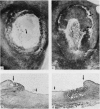Abstract
The effect of extirpation of the submandibular glands, an exocrine organ for epidermal growth factor/urogastrone (EGF/URO), and the effect of oral administration of synthetic human (EGF/URO) on healing of chronic gastric ulcers in rats has been investigated. Removal of the submandibular glands delayed healing of chronic gastric ulcers when examined after 50, 100, and 200 days. Oral administration of synthetic human EGF/URO stimulated gastric ulcer healing when examined after 25 and 50 days of treatment. The effect of synthetic human EGF/URO was comparable with that of cimetidine. The combined administration of synthetic human EGF/URO and cimetidine further increased healing of gastric ulcers compared with administration of each substance. Neither synthetic human EGF/URO, nor removal of the submandibular glands had any influence on gastric acid secretion. This study showed that the submandibular glands influence healing of chronic gastric ulcers and suggest that EGF/URO participate in healing of chronic gastric ulcers in rats.
Full text
PDF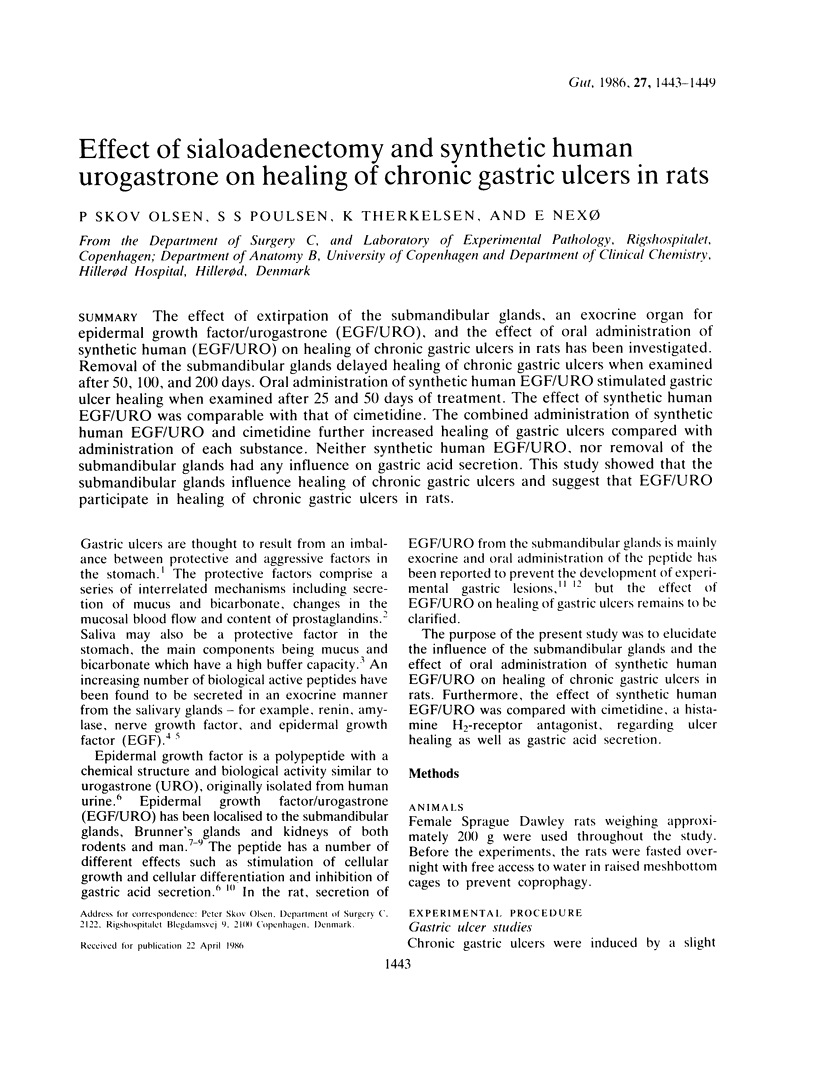
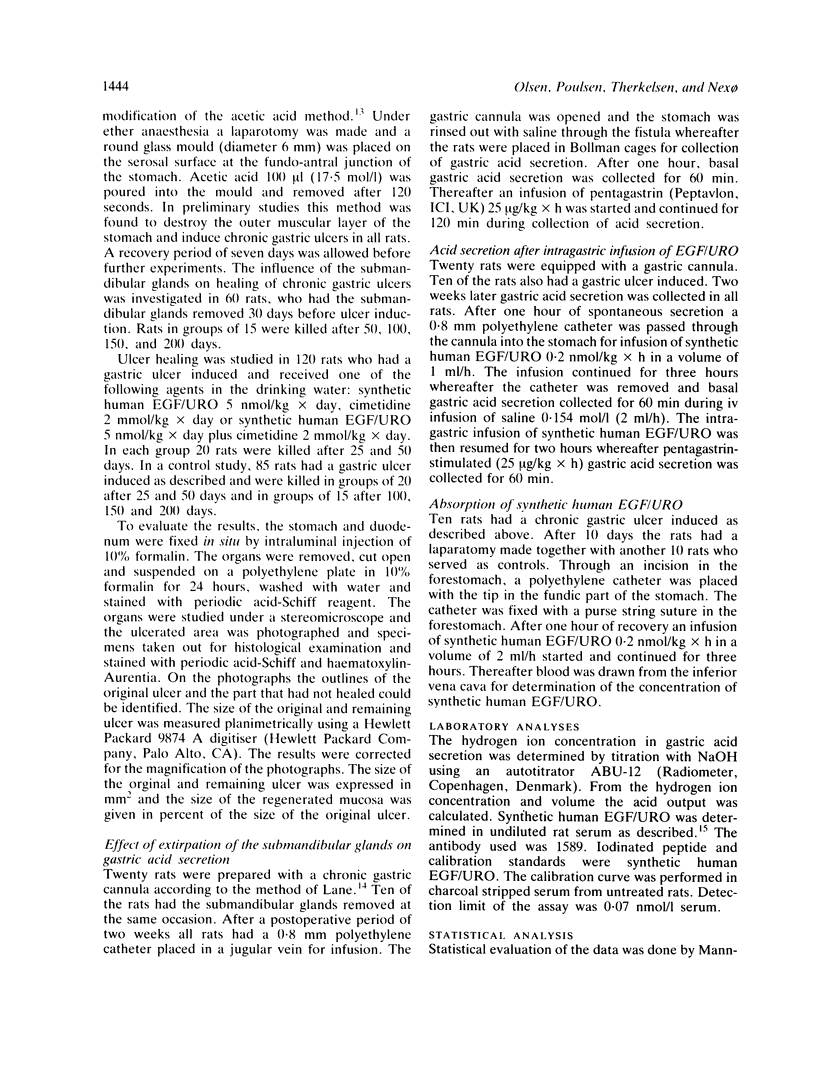
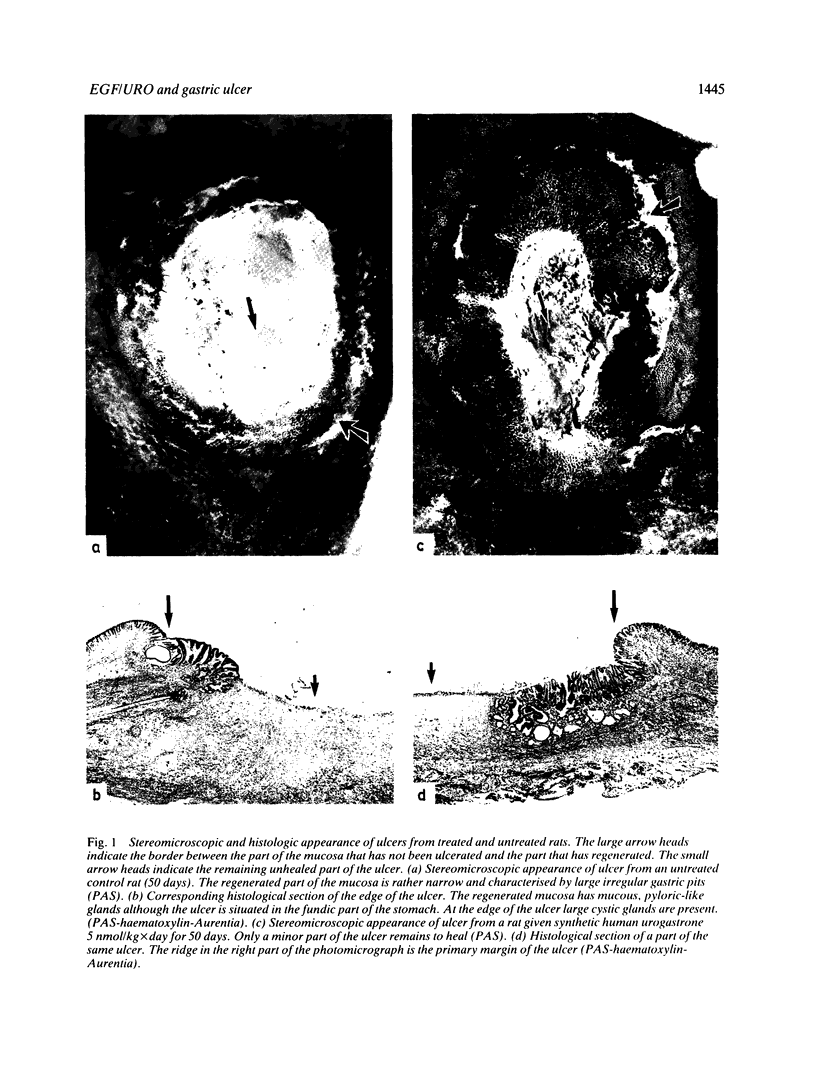
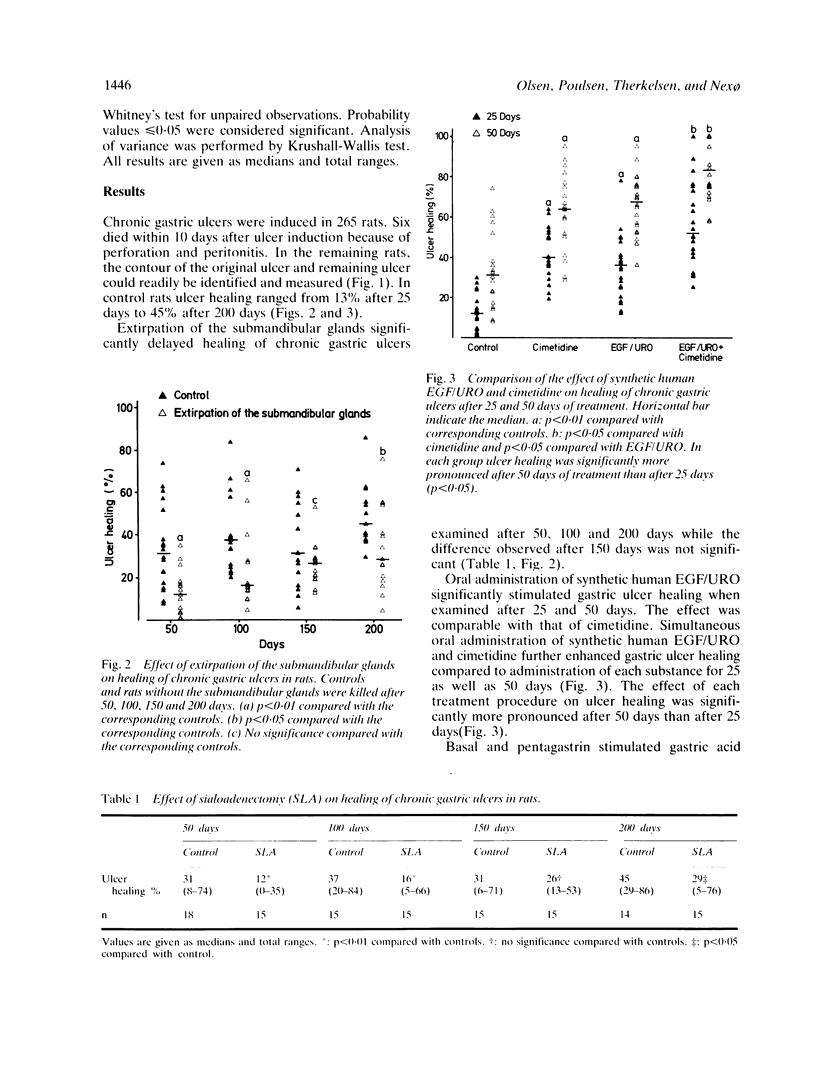
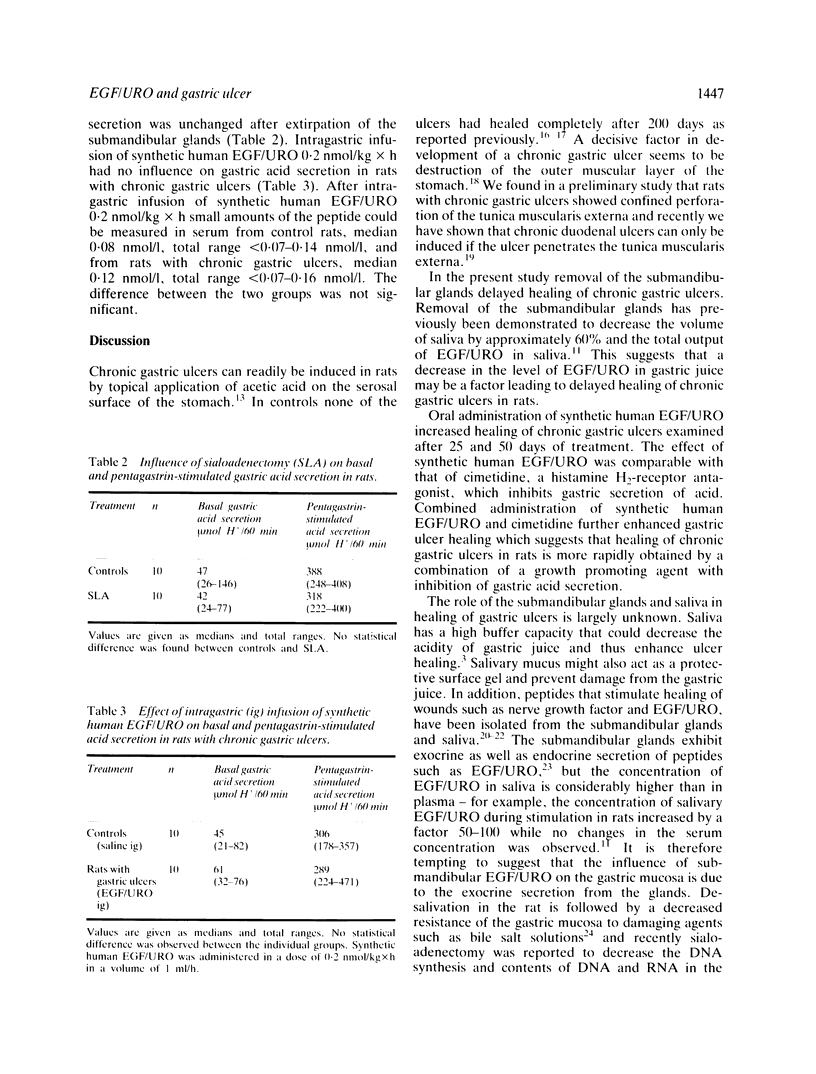
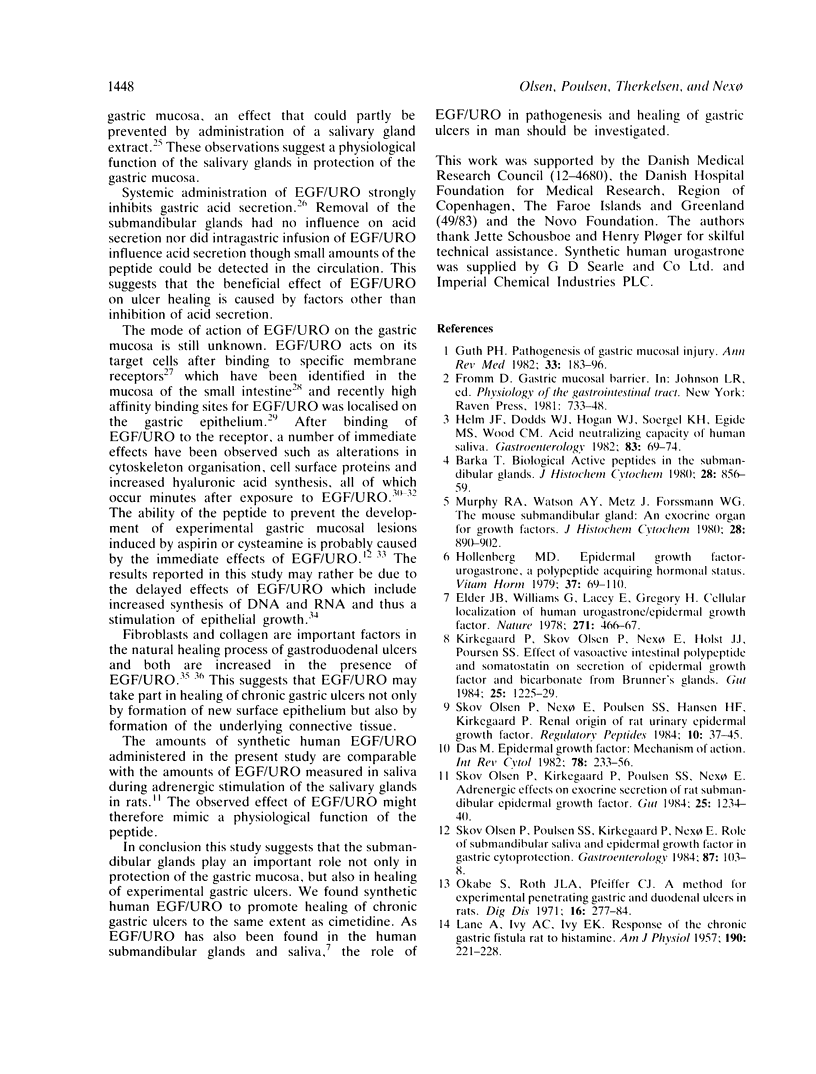
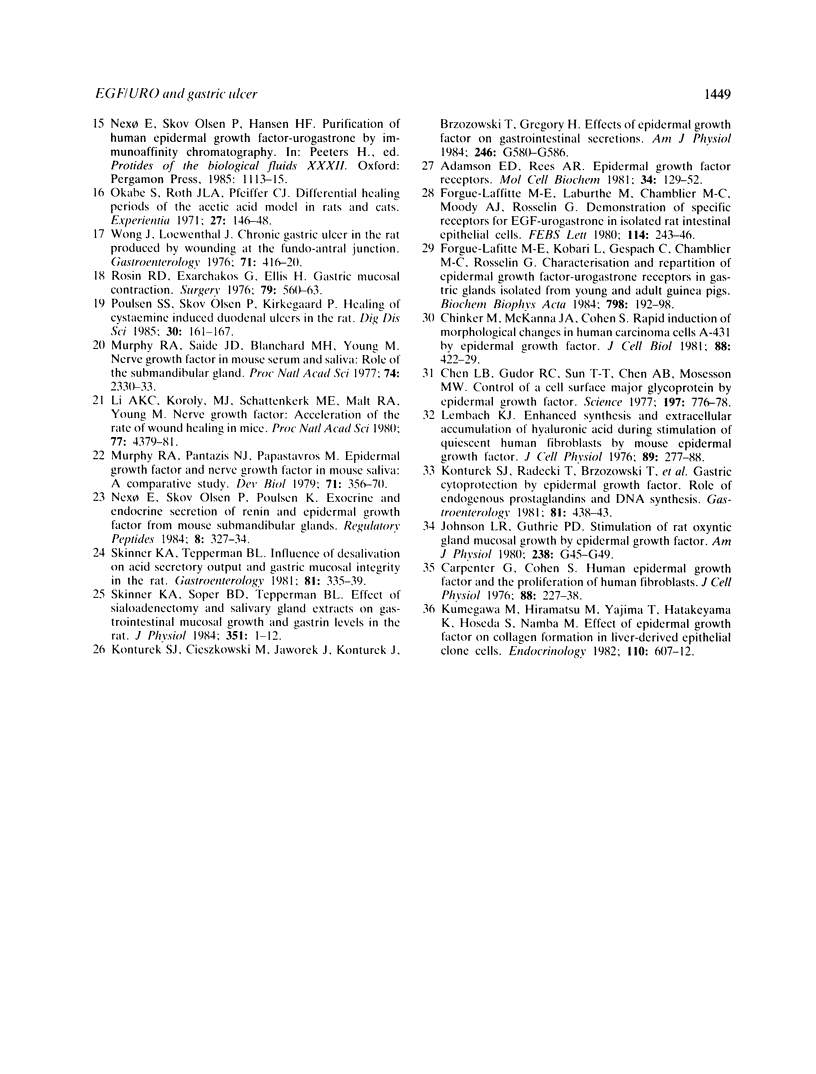
Images in this article
Selected References
These references are in PubMed. This may not be the complete list of references from this article.
- Adamson E. D., Rees A. R. Epidermal growth factor receptors. Mol Cell Biochem. 1981 Feb 11;34(3):129–152. doi: 10.1007/BF02359619. [DOI] [PubMed] [Google Scholar]
- Carpenter G., Cohen S. Human epidermal growth factor and the proliferation of human fibroblasts. J Cell Physiol. 1976 Jun;88(2):227–237. doi: 10.1002/jcp.1040880212. [DOI] [PubMed] [Google Scholar]
- Chen L. B., Gudor R. C., Sun T. T., Chen A. B., Mosesson M. W. Control of a cell surface major glycoprotein by epidermal growth factor. Science. 1977 Aug 19;197(4305):776–778. doi: 10.1126/science.302030. [DOI] [PubMed] [Google Scholar]
- Chinkers M., McKanna J. A., Cohen S. Rapid rounding of human epidermoid carcinoma cells A-431 induced by epidermal growth factor. J Cell Biol. 1981 Feb;88(2):422–429. doi: 10.1083/jcb.88.2.422. [DOI] [PMC free article] [PubMed] [Google Scholar]
- Das M. Epidermal growth factor: mechanisms of action. Int Rev Cytol. 1982;78:233–256. doi: 10.1016/s0074-7696(08)60107-2. [DOI] [PubMed] [Google Scholar]
- Elder J. B., Williams G., Lacey E., Gregory H. Cellular localisation of human urogastrone/epidermal growth factor. Nature. 1978 Feb 2;271(5644):466–467. doi: 10.1038/271466a0. [DOI] [PubMed] [Google Scholar]
- Forgue-Lafitte M. E., Kobari L., Gespach C., Chamblier M. C., Rosselin G. Characterization and repartition of epidermal growth factor-urogastrone receptors in gastric glands isolated from young and adult guinea pigs. Biochim Biophys Acta. 1984 Apr 10;798(2):192–198. doi: 10.1016/0304-4165(84)90303-9. [DOI] [PubMed] [Google Scholar]
- Forgue-Lafitte M. E., Laburthe M., Chamblier M. C., Moody A. J., Rosselin G. Demonstration of specific receptors for EGF--urogastrone in isolated rat intestinal epithelial cells. FEBS Lett. 1980 Jun 2;114(2):243–246. doi: 10.1016/0014-5793(80)81125-2. [DOI] [PubMed] [Google Scholar]
- Guth P. H. Pathogenesis of gastric mucosal injury. Annu Rev Med. 1982;33:183–196. doi: 10.1146/annurev.me.33.020182.001151. [DOI] [PubMed] [Google Scholar]
- Helm J. F., Dodds W. J., Hogan W. J., Soergel K. H., Egide M. S., Wood C. M. Acid neutralizing capacity of human saliva. Gastroenterology. 1982 Jul;83(1 Pt 1):69–74. [PubMed] [Google Scholar]
- Hollenberg M. D. Epidermal growth factor-urogastrone, a polypeptide acquiring hormonal status. Vitam Horm. 1979;37:69–110. doi: 10.1016/s0083-6729(08)61068-7. [DOI] [PubMed] [Google Scholar]
- Johnson L. R., Guthrie P. D. Stimulation of rat oxyntic gland mucosal growth by epidermal growth factor. Am J Physiol. 1980 Jan;238(1):G45–G49. doi: 10.1152/ajpgi.1980.238.1.G45. [DOI] [PubMed] [Google Scholar]
- Konturek S. J., Cieszkowski M., Jaworek J., Konturek J., Brzozowski T., Gregory H. Effects of epidermal growth factor on gastrointestinal secretions. Am J Physiol. 1984 May;246(5 Pt 1):G580–G586. doi: 10.1152/ajpgi.1984.246.5.G580. [DOI] [PubMed] [Google Scholar]
- Kumegawa M., Hiramatsu M., Yajima T., Hatakeyama K., Hosoda S., Namba M. Effect of epidermal growth factor on collagen formation in liver-derived epithelial clone cells. Endocrinology. 1982 Feb;110(2):607–612. doi: 10.1210/endo-110-2-607. [DOI] [PubMed] [Google Scholar]
- Lembach K. J. Enhanced synthesis and extracellular accumulation of hyaluronic acid during stimulation of quiescent human fibroblasts by mouse epidermal growth factor. J Cell Physiol. 1976 Oct;89(2):277–288. doi: 10.1002/jcp.1040890211. [DOI] [PubMed] [Google Scholar]
- Li A. K., Koroly M. J., Schattenkerk M. E., Malt R. A., Young M. Nerve growth factor: acceleration of the rate of wound healing in mice. Proc Natl Acad Sci U S A. 1980 Jul;77(7):4379–4381. doi: 10.1073/pnas.77.7.4379. [DOI] [PMC free article] [PubMed] [Google Scholar]
- Murphy R. A., Pantazis N. J., Papastavros M. Epidermal growth factor and nerve growth factor in mouse saliva: a comparative study. Dev Biol. 1979 Aug;71(2):356–370. doi: 10.1016/0012-1606(79)90175-1. [DOI] [PubMed] [Google Scholar]
- Murphy R. A., Saide J. D., Blanchard M. H., Young M. Nerve growth factor in mouse serum and saliva: role of the submandibular gland. Proc Natl Acad Sci U S A. 1977 Jun;74(6):2330–2333. doi: 10.1073/pnas.74.6.2330. [DOI] [PMC free article] [PubMed] [Google Scholar]
- Murphy R. A., Watson A. Y., Metz J., Forssmann W. G. The mouse submandibular gland: an exocrine organ for growth factors. J Histochem Cytochem. 1980 Aug;28(8):890–902. doi: 10.1177/28.8.6969274. [DOI] [PubMed] [Google Scholar]
- Okabe S., Roth J. L., Pfeiffer C. J. A method for experimental, penetrating gastric and duodenal ulcers in rats. Observations on normal healing. Am J Dig Dis. 1971 Mar;16(3):277–284. doi: 10.1007/BF02235252. [DOI] [PubMed] [Google Scholar]
- Okabe S., Roth J. L., Pfeiffer C. J. Differential healing periods of the acetic acid ulcer model in rats and cats. Experientia. 1971 Feb 15;27(2):146–148. doi: 10.1007/BF02145860. [DOI] [PubMed] [Google Scholar]
- Poulsen S. S., Olsen P. S., Kirkegaard P. Healing of cysteamine-induced duodenal ulcers in the rat. Dig Dis Sci. 1985 Feb;30(2):161–167. doi: 10.1007/BF01308204. [DOI] [PubMed] [Google Scholar]
- Rosin R. D., Exarchakos G., Ellis H. Gastric mucosal contraction. Surgery. 1976 May;79(5):560–563. [PubMed] [Google Scholar]
- Skinner K. A., Soper B. D., Tepperman B. L. Effect of sialoadenectomy and salivary gland extracts on gastrointestinal mucosal growth and gastrin levels in the rat. J Physiol. 1984 Jun;351:1–12. doi: 10.1113/jphysiol.1984.sp015227. [DOI] [PMC free article] [PubMed] [Google Scholar]
- Skinner K. A., Tepperman B. L. Influence of desalivation on acid secretory output and gastric mucosal integrity in the rat. Gastroenterology. 1981 Aug;81(2):335–339. [PubMed] [Google Scholar]
- Skov Olsen P., Nexø E., Poulsen S. S., Hansen H. F., Kirkegaard P. Renal origin of rat urinary epidermal growth factor. Regul Pept. 1984 Dec;10(1):37–45. doi: 10.1016/0167-0115(84)90051-x. [DOI] [PubMed] [Google Scholar]



